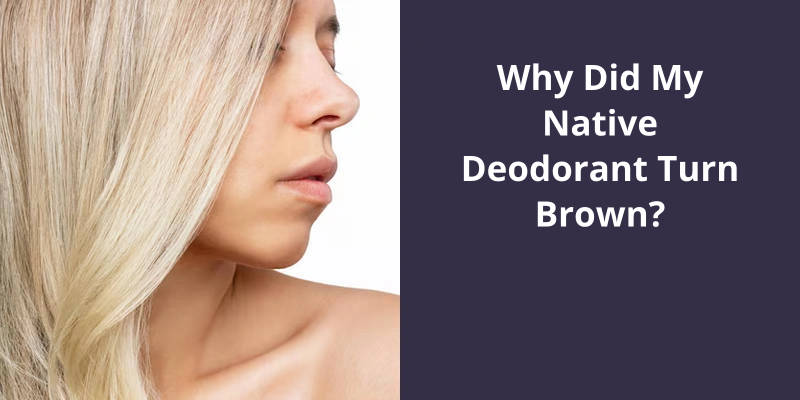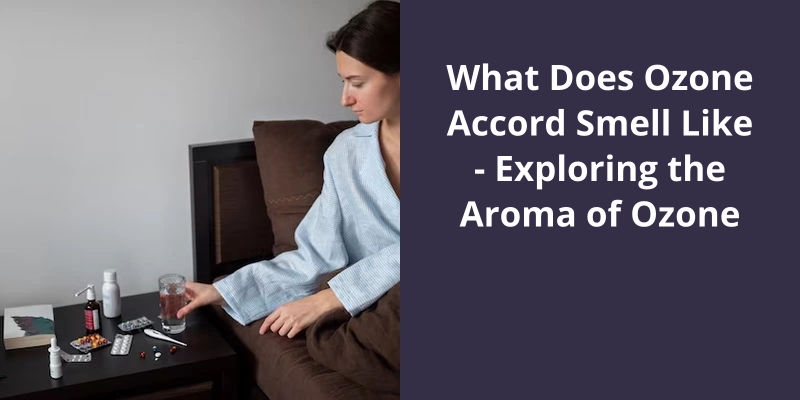Your Native deodorant likely turned brown due to the presence of natural ingredients such as baking soda, coconut oil, and shea butter that can change color when exposed to variations in temperature or light. More specifically, when these oils and butter melt and then solidify repeatedly, it may result in discoloration. Furthermore, certain fragrance components used in Native deodorants can also trigger color changes upon exposure to different environmental conditions. However, it’s important to note that, while the deodorant may not look as aesthetically pleasing, these changes in color do not impact the safety or effectiveness of the product.

Why Does Deodorant Turn My Armpits Brown?
Post-inflammatory hyperpigmentation (PIH) is a common occurrence that causes skin darkening, and deodorants can be one of the culprits. According to an expert, PIH is the result of skin irritation or damage, which triggers the production of melanin, the pigment responsible for skin darkening.
Deodorants, especially those that contain irritants like alcohol or fragrances, can cause irritation or inflammation on the delicate skin of our armpits. This can lead to the activation of our bodys defense mechanisms, including the production of melanin. As a result, the affected area may start to darken, giving it a brownish appearance.
It’s important to note that everyones skin reacts differently to various products, and some individuals may be more prone to developing PIH than others. People with sensitive skin or those who frequently shave their underarms may be more susceptible to this phenomenon.
To prevent or minimize the risk of deodorant-induced darkening, it’s advisable to opt for deodorants specifically formulated for sensitive skin or free from potential irritants. Additionally, giving your skin a break from deodorant every now and then, allowing it to breathe and recover, can also help.
If you notice significant darkening or changes in the appearance of your armpits, it’s always recommended to consult with a dermatologist. They can provide a proper diagnosis and suggest suitable treatments or skincare routines to address the issue effectively.
Overall, the darkening of armpits due to deodorant use is a common concern caused by post-inflammatory hyperpigmentation. Understanding the causes and taking appropriate preventive measures can help alleviate this issue and maintain healthy, evenly toned underarm skin.
Common Irritants Found in Deodorants That Can Cause Skin Darkening
- Fragrances
- Alcohol
- Parabens
- Propylene glycol
- Triclosan
- Aluminum compounds
- Formaldehyde
- Phthalates
- Artificial colors
- Mineral oil
One thing is clear – natural deodorant doesn’t always last as long as it’s conventional counterparts. The reason behind this lies in the bacteria that reside on our skin. However, finding the best natural deodorant for you can make a significant difference. While some individuals may find success with formulas containing baking soda, others may need ingredients like zinc, magnesium, or clays to effectively combat bacterial growth and odor.
Why Does Natural Deodorant Not Last Long?
One of the most frustrating aspects of using natural deodorant is it’s short lifespan. Unlike conventional deodorants, which often provide all-day protection, natural deodorants tend to wear off much quicker. But why does this happen? The answer lies in the bacteria that naturally live on your skin.
Bacteria thrive in warm, moist environments, and your underarms provide the perfect breeding ground. When you sweat, these bacteria break down the sweat and produce compounds that cause unpleasant odors. Natural deodorants, which are usually made with plant-based ingredients, may not contain the powerful chemicals found in conventional deodorants that can kill or neutralize these bacteria.
To combat the bacterial onslaught, it’s important to find a natural deodorant that effectively addresses this issue. Some people have success with formulas that include baking soda. Baking soda helps to neutralize odors and create an alkaline environment that’s unfavorable for bacteria growth. However, for those with sensitive skin or allergies, baking soda may cause irritation or redness.
Another option to consider is a natural deodorant that includes clays, such as bentonite or kaolin clay. Clays have detoxifying properties that can help draw out impurities and control odor-causing bacteria. They can also help absorb excess moisture, keeping your underarms dry and less prone to bacterial growth.
Ultimately, finding the best natural deodorant for you may require some trial and error. Everyones body chemistry is different, and what works for one person may not work for another. It may be helpful to experiment with different formulas and ingredients until you find the one that effectively addresses your bodys bacterial population and offers long-lasting protection against odors.
During this transition period, your body may release more sweat and odor as it adjusts to the absence of aluminum-based antiperspirants. However, with patience and persistence, natural deodorants can eventually regain their effectiveness and provide a more sustainable and healthier alternative. So, don’t give up on natural deodorants just yet.
Why Does Natural Deodorant Stop Working After a While?
Why did my native deodorant turn brown? One possibility is that it’s been exposed to air for too long. Natural deodorants often contain ingredients like shea butter or coconut oil, which can oxidize and change color when exposed to air. Another possibility is that the deodorant has reacted with bacteria on your skin, causing it to darken in color. This is more likely to happen if you apply the deodorant to wet or damp skin, as bacteria thrive in moist environments. Additionally, if your deodorant contains ingredients like baking soda or apple cider vinegar, these can also cause discoloration over time.
But why does natural deodorant stop working after a while? The answer lies in the way our bodies adapt to certain substances. When you use traditional deodorants that contain aluminum compounds, they form a plug in your sweat glands, blocking perspiration. Over time, your body becomes reliant on these plugs to prevent sweating. However, when you switch to a natural deodorant that doesn’t contain aluminum, your body is no longer able to rely on these plugs. As a result, your sweat glands start working again, and you may experience increased sweating initially.
This detox period can be frustrating, as it may take some time for your body to adjust. During this period, it’s common for natural deodorants to seem ineffective, leaving you feeling self-conscious about body odor. However, it’s important to give your body time to return to it’s natural state. This transition period varies for each individual, but it typically lasts anywhere from a few days to a few weeks. Eventually, your body will regulate it’s sweat production, and the natural deodorant should start working effectively again.
How to Choose the Right Natural Deodorant for Your Body
- Consider your body’s needs:
- If you’ve sensitive skin, look for natural deodorants that are formulated without harsh chemicals or fragrances.
- If you sweat heavily, opt for a natural deodorant with strong odor-fighting ingredients like baking soda or activated charcoal.
- If you’re prone to body odor, choose a natural deodorant that contains antibacterial ingredients like tea tree oil or witch hazel.
- Read the ingredient list:
- Avoid natural deodorants that contain aluminum, parabens, and synthetic fragrances.
- Look for ingredients like coconut oil, shea butter, and essential oils, which can be soothing and moisturizing for your skin.
- Test it out:
- Before committing to a natural deodorant, try a sample or travel-sized version to make sure it works well for your body.
- Give your body a few days to adjust to the new formula, as your body might need time to detox from the chemicals in conventional deodorants.
- Consider the application method:
- There are various application methods for natural deodorants, including solid sticks, creams, roll-ons, and sprays.
- Choose the application method that’s most convenient and comfortable for you.
- Check for additional features:
- Some natural deodorants offer additional benefits, such as long-lasting protection, stain resistance, or eco-friendly packaging.
- Consider these features based on your personal preferences and needs.
In addition to skin irritation and inflammation caused by certain ingredients in deodorants, another factor that may contribute to underarm darkening is the use of antiperspirants containing aluminum. The primary function of aluminum is to block sweat ducts, leading to dryness. However, this can also lead to the accumulation of pigmentation in the underarm area over time.
Why Is My Deodorant Making My Underarms Dark?
One common issue that many people experience with deodorants is the darkening of their underarms. This can be quite frustrating, as it not only affects the appearance of the skin but can also cause discomfort and self-consciousness. But why does this happen?
Parabens, which are preservatives used in many skincare products, have been known to cause skin irritation and inflammation. This irritation can lead to thickening of the skin and the subsequent darkening of the underarms over time.
Perhaps one of the most well-known ingredients that can cause dark underarms is aluminum. Aluminum is an active ingredient in many antiperspirants, which are intended to block sweat ducts and reduce perspiration.
Some individuals may be more prone to this issue due to their individual skin type or sensitivities. Additionally, the severity of the darkening can vary from person to person, with some experiencing only a slight discoloration while others may see more noticeable changes.
These types of deodorants often don’t contain the same harsh ingredients that can cause skin irritation and darkening. Of course, it’s always a good idea to consult with a dermatologist if you’ve any concerns about your skins health or if the darkening persists despite changes in deodorant brands.
Natural and Organic Deodorant Alternatives
Many people choose to switch to natural and organic deodorant alternatives for various reasons. These alternatives are typically made with natural ingredients, such as essential oils, baking soda, and coconut oil, rather than the potentially harmful chemicals found in conventional deodorants.
One common issue that users may experience with natural deodorants is the product turning brown. This discoloration is typically caused by the natural ingredients in the deodorant reacting with the air or your body’s pH. It’s a normal and harmless occurrence, and it doesn’t affect the deodorant’s effectiveness.
If your natural deodorant turns brown, there’s no need to be alarmed. Simply give the product a good stir or shake to redistribute the ingredients before applying. This should help restore the product to it’s original consistency. However, if you’re concerned or if the odor becomes unpleasant, you may consider contacting the manufacturer for further guidance.
Remember, when making the switch to natural and organic deodorant alternatives, it’s important to give your body time to adjust. Some people may experience a detox period during which they may sweat more or notice an increase in body odor. This is a temporary adjustment as your body adjusts to the new formula.
Overall, natural and organic deodorant alternatives provide a safer and more environmentally friendly option for those looking to reduce their exposure to harmful chemicals. If you’re considering making the switch, it’s important to understand that discoloration is a normal occurrence and doesn’t affect the product’s effectiveness.
If you’ve been using your native deodorant for a while and can’t remember when you bought it, it’s important to check for the expiration date. Typically, you can find it on the bottom of the deodorant. However, if you can’t find an expiration date, it’s crucial to inspect the deodorant for any signs of mold. Additionally, giving it a sniff can help determine if any of the ingredients have started to smell off, indicating expiration.
Where Is Expiration Date on Native Deodorant?
When it comes to determining the expiration date on your Native deodorant, it’s essential to locate the packaging label first. Take a moment to flip the deodorant over and carefully check for any date mentioned. While it may vary depending on the specific packaging design, the bottom is usually a common spot for the expiration date to be displayed.
If, by any chance, you find that your Native deodorant doesn’t have an expiration date mentioned, it’s crucial to inspect it for any signs of mold or other forms of contamination. Although natural deodorants are formulated to be more resistant to such issues, it’s always wise to be cautious. Take a closer look at the deodorant, paying attention to any discoloration, unusual textures, or growths that may indicate the presence of mold.
Additionally, if youre unsure about the freshness of your Native deodorant, you can rely on your sense of smell to help you identify any potential problems. Give it a gentle sniff and trust your instincts. Some natural deodorant ingredients may start to emit an unpleasant odor once they expire or become contaminated.
How to Properly Store Native Deodorant to Extend It’s Shelf Life
To properly store your Native deodorant and extend it’s shelf life, you should keep it in a cool, dry place away from direct sunlight and excessive heat. Avoid storing it in a bathroom or humid environment as the moisture may cause the deodorant to turn brown. Additionally, ensure that the cap is tightly sealed after each use to prevent air exposure which can also contribute to discoloration. By following these simple storage tips, you can enjoy the full longevity of your Native deodorant.
Source: Does Deodorant Expire? Tiege Hanley
Conclusion
In conclusion, the phenomenon of Native Deodorant turning brown can be attributed to various factors such as oxidation, pH imbalance, or the presence of certain minerals in our sweat. While this discoloration may seem alarming, it doesn’t necessarily indicate that the product is unsafe or ineffective. It’s important to understand that cosmetic products, including deodorants, can undergo natural color changes over time. However, if you notice any drastic changes in odor, consistency, or irritation after using a discolored deodorant, it’s advisable to discontinue it’s use and consult a healthcare professional. Overall, it’s crucial to store deodorants properly, minimize exposure to air and sunlight, and utilize within their recommended shelf life to maintain their optimal effectiveness.





